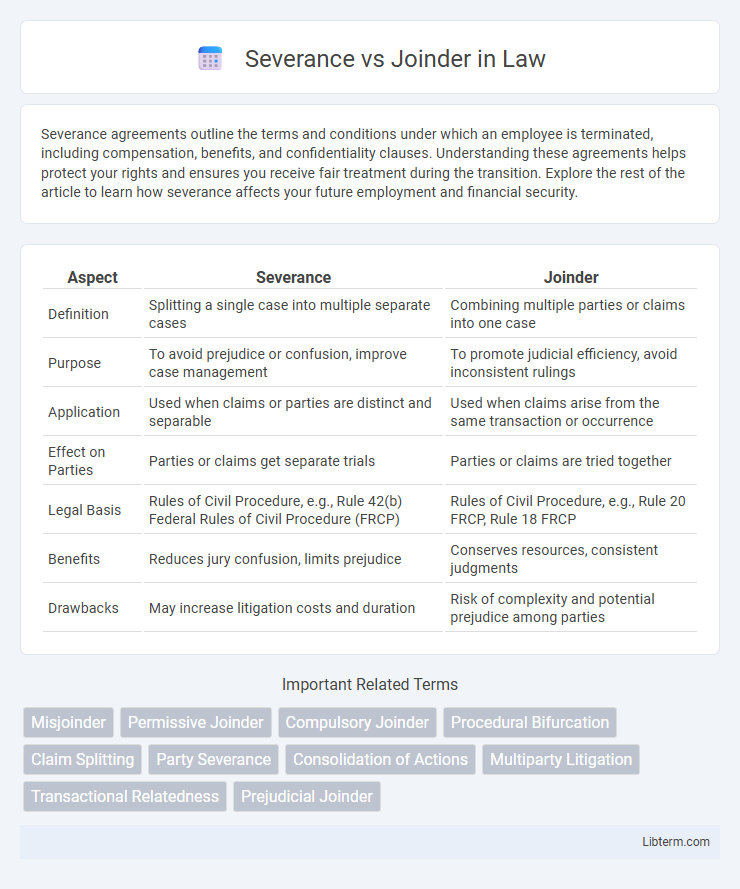Severance agreements outline the terms and conditions under which an employee is terminated, including compensation, benefits, and confidentiality clauses. Understanding these agreements helps protect your rights and ensures you receive fair treatment during the transition. Explore the rest of the article to learn how severance affects your future employment and financial security.
Table of Comparison
| Aspect | Severance | Joinder |
|---|---|---|
| Definition | Splitting a single case into multiple separate cases | Combining multiple parties or claims into one case |
| Purpose | To avoid prejudice or confusion, improve case management | To promote judicial efficiency, avoid inconsistent rulings |
| Application | Used when claims or parties are distinct and separable | Used when claims arise from the same transaction or occurrence |
| Effect on Parties | Parties or claims get separate trials | Parties or claims are tried together |
| Legal Basis | Rules of Civil Procedure, e.g., Rule 42(b) Federal Rules of Civil Procedure (FRCP) | Rules of Civil Procedure, e.g., Rule 20 FRCP, Rule 18 FRCP |
| Benefits | Reduces jury confusion, limits prejudice | Conserves resources, consistent judgments |
| Drawbacks | May increase litigation costs and duration | Risk of complexity and potential prejudice among parties |
Introduction to Severance and Joinder
Severance refers to the legal process of splitting a single lawsuit involving multiple claims or defendants into separate cases to promote clarity and judicial efficiency. Joinder allows multiple related claims or parties to be combined in one lawsuit to avoid inconsistent judgments and conserve judicial resources. Understanding the distinctions between severance and joinder is essential for effective case management and procedural strategy in litigation.
Definitions: What is Severance?
Severance is a legal procedure that separates multiple claims, parties, or issues in a single lawsuit into distinct cases to ensure clarity and fairness during trial. This process helps prevent prejudice to any party and promotes judicial efficiency by addressing complex matters individually. Courts often grant severance when combining issues would cause confusion, unnecessary delay, or prejudice.
Definitions: What is Joinder?
Joinder is a legal procedure that allows multiple parties or claims to be combined into a single lawsuit to promote judicial efficiency and avoid multiple trials. It involves joining either several plaintiffs or defendants, or related causes of action, under one case when their issues of law or fact overlap. This process is governed by rules such as Federal Rules of Civil Procedure Rule 20, ensuring cases with common questions are heard together.
Key Differences Between Severance and Joinder
Severance involves splitting a single legal claim or defendant into separate actions to avoid prejudice or confusion, while joinder combines multiple claims or parties into one lawsuit to promote judicial efficiency. Key differences include severance separating cases to ensure fair trial and clarity, whereas joinder consolidates related claims or parties to save time and resources. Severance is often requested when claims are distinct or risk conflicting outcomes, whereas joinder applies when claims arise from the same transaction or common question of law or fact.
Legal Criteria for Granting Severance
Legal criteria for granting severance focus on the potential for prejudice, ensuring fair trial rights are preserved when multiple defendants or claims are involved. Courts consider whether joinder causes confusion, delays, or risk of undue prejudice affecting the jury's ability to fairly evaluate separate issues. The analysis includes overlap of evidence, potential for conflicting defenses, and whether severance would promote judicial efficiency without compromising justice.
Legal Criteria for Allowing Joinder
Legal criteria for allowing joinder require that claims or parties share a common question of law or fact, ensuring judicial efficiency and consistency in rulings. Courts evaluate whether joinder avoids prejudice or confusion and whether it promotes the speedy resolution of disputes. The Federal Rules of Civil Procedure, particularly Rule 20, guide these determinations by permitting joinder when claims arise from the same transaction, occurrence, or series of transactions.
Benefits and Drawbacks of Severance
Severance offers the benefit of simplifying complex cases by separating claims or parties, which can lead to more focused trials and potentially quicker resolutions. However, drawbacks include increased litigation costs due to multiple proceedings and the risk of inconsistent verdicts across related cases. Courts often weigh these factors to balance judicial efficiency against fairness to all parties involved.
Benefits and Drawbacks of Joinder
Joinder allows multiple parties or claims to be combined into a single lawsuit, which promotes judicial efficiency by reducing duplication of proceedings and conserving court resources. It benefits parties by minimizing legal costs and preventing inconsistent judgments across related cases. However, joinder may complicate litigation by increasing case complexity, potentially causing delays and disadvantaging parties with simpler claims or less extensive evidence.
Case Law Examples: Severance vs Joinder
Severance and joinder are procedural tools used in litigation to manage multiple claims or parties, with severance splitting a case into separate actions and joinder combining multiple claims or parties into one suit. In *Zafiro v. United States*, 506 U.S. 534 (1993), the Supreme Court emphasized severance to avoid prejudice and confusion in criminal trials, underscoring the importance of separate trials for distinct defendants to ensure fair adjudication. Conversely, in *United Mine Workers v. Gibbs*, 383 U.S. 715 (1966), the Court upheld joinder under supplemental jurisdiction to promote judicial efficiency by resolving related claims involving the same set of facts within a single proceeding.
Choosing Between Severance and Joinder in Litigation
Choosing between severance and joinder in litigation hinges on considerations such as judicial efficiency, potential prejudice to parties, and the nature of the claims involved. Joinder permits the consolidation of multiple parties or claims in a single lawsuit, promoting streamlined case management and resource conservation, while severance Splits claims or parties into separate actions to prevent jury confusion or unfair prejudice. Courts often evaluate factors like the commonality of legal and factual issues, risk of inconsistent verdicts, and potential impact on judicial economy when determining whether severance or joinder better serves the interests of justice.
Severance Infographic

 libterm.com
libterm.com